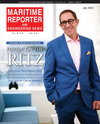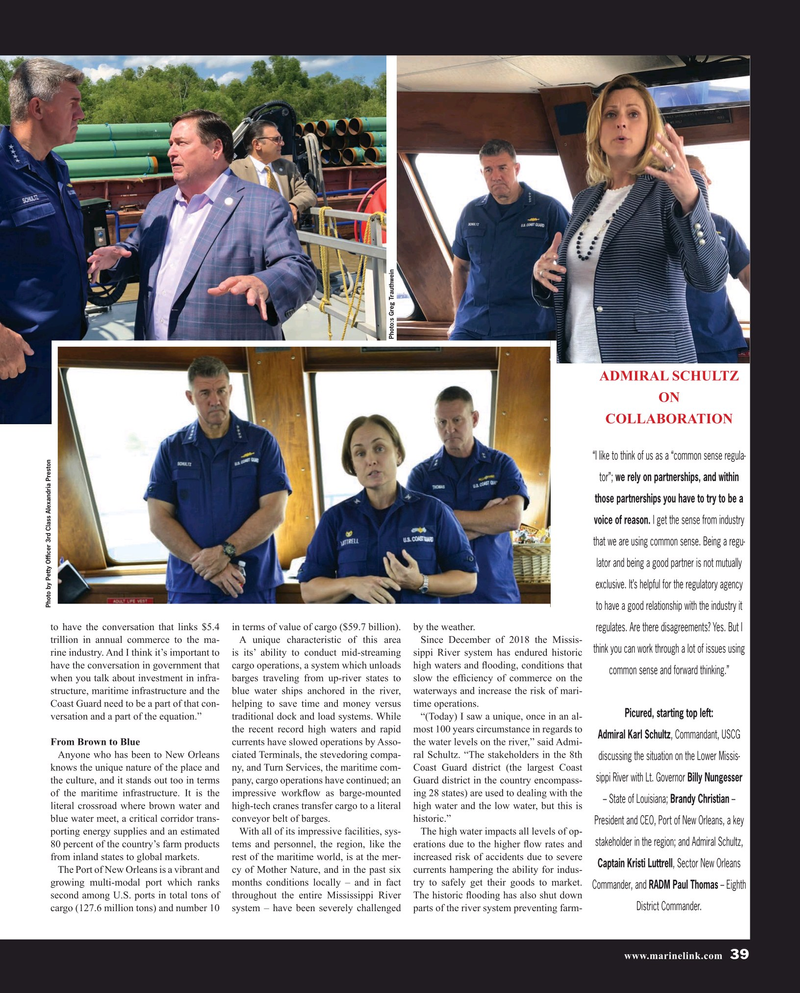
Page 39: of Maritime Reporter Magazine (July 2019)
Cruise Vessel Design & Outfit
Read this page in Pdf, Flash or Html5 edition of July 2019 Maritime Reporter Magazine
Photo:s Greg Trauthwein
ADMIRAL SCHULTZ
ON
COLLABORATION “I like to think of us as a “common sense regula- tor”; we rely on partnerships, and within those partnerships you have to try to be a voice of reason. I get the sense from industry that we are using common sense. Being a regu- lator and being a good partner is not mutually exclusive. It’s helpful for the regulatory agency
Photo by Petty Of? cer 3rd Class Alexandria Preston to have a good relationship with the industry it to have the conversation that links $5.4 in terms of value of cargo ($59.7 billion). by the weather.
regulates. Are there disagreements? Yes. But I trillion in annual commerce to the ma- A unique characteristic of this area Since December of 2018 the Missis- think you can work through a lot of issues using rine industry. And I think it’s important to is its’ ability to conduct mid-streaming sippi River system has endured historic have the conversation in government that cargo operations, a system which unloads high waters and ? ooding, conditions that common sense and forward thinking.” when you talk about investment in infra- barges traveling from up-river states to slow the ef? ciency of commerce on the structure, maritime infrastructure and the blue water ships anchored in the river, waterways and increase the risk of mari-
Coast Guard need to be a part of that con- helping to save time and money versus time operations.
Picured, starting top left: versation and a part of the equation.” traditional dock and load systems. While “(Today) I saw a unique, once in an al- the recent record high waters and rapid most 100 years circumstance in regards to
Admiral Karl Schultz, Commandant, USCG
From Brown to Blue currents have slowed operations by Asso- the water levels on the river,” said Admi-
Anyone who has been to New Orleans ciated Terminals, the stevedoring compa- ral Schultz. “The stakeholders in the 8th discussing the situation on the Lower Missis- knows the unique nature of the place and ny, and Turn Services, the maritime com- Coast Guard district (the largest Coast sippi River with Lt. Governor Billy Nungesser the culture, and it stands out too in terms pany, cargo operations have continued; an Guard district in the country encompass- of the maritime infrastructure. It is the impressive work? ow as barge-mounted ing 28 states) are used to dealing with the – State of Louisiana; Brandy Christian – literal crossroad where brown water and high-tech cranes transfer cargo to a literal high water and the low water, but this is blue water meet, a critical corridor trans- conveyor belt of barges. historic.”
President and CEO, Port of New Orleans, a key porting energy supplies and an estimated With all of its impressive facilities, sys- The high water impacts all levels of op- stakeholder in the region; and Admiral Schultz, 80 percent of the country’s farm products tems and personnel, the region, like the erations due to the higher ? ow rates and from inland states to global markets. rest of the maritime world, is at the mer- increased risk of accidents due to severe
Captain Kristi Luttrell, Sector New Orleans
The Port of New Orleans is a vibrant and cy of Mother Nature, and in the past six currents hampering the ability for indus- growing multi-modal port which ranks months conditions locally – and in fact try to safely get their goods to market.
Commander, and RADM Paul Thomas – Eighth second among U.S. ports in total tons of throughout the entire Mississippi River The historic ? ooding has also shut down
District Commander.
cargo (127.6 million tons) and number 10 system – have been severely challenged parts of the river system preventing farm- www.marinelink.com 39
MR #7 (34-41).indd 39 7/8/2019 10:22:17 AM

 38
38

 40
40
